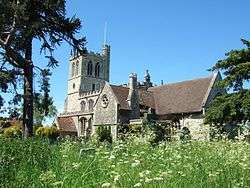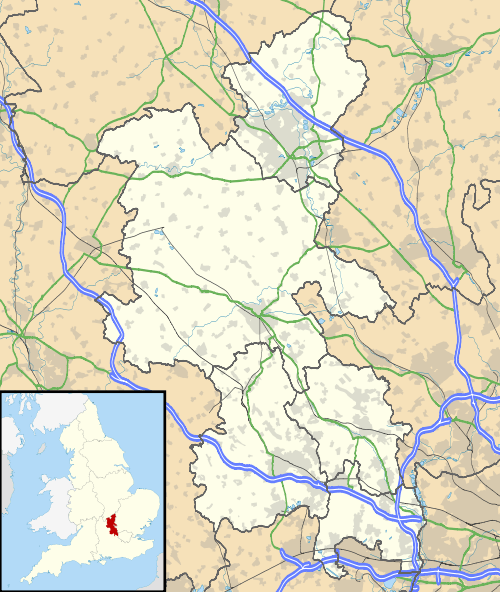Wingrave
| Wingrave | |
 SS Peter & Paul, Wingrave |
|
 Wingrave |
|
| Population | 1,512 (2011 Census)[1] |
|---|---|
| OS grid reference | SP858183 |
| Civil parish | Wingrave |
| District | Aylesbury Vale |
| Shire county | Buckinghamshire |
| Region | South East |
| Country | England |
| Sovereign state | United Kingdom |
| Post town | AYLESBURY |
| Postcode district | HP22 |
| Dialling code | 01296 |
| Police | Thames Valley |
| Fire | Buckinghamshire |
| Ambulance | South Central |
| EU Parliament | South East England |
| UK Parliament | Buckingham |
|
|
Coordinates: 51°51′50″N 0°44′19″W / 51.8638°N 0.7387°W
Wingrave is a village in Buckinghamshire, England, about four miles north east of Aylesbury and three miles south west of Wing.
The civil parish is called Wingrave with Rowsham within Aylesbury Vale district and incorporates the hamlet of Rowsham.
Wingrave is twinned with La Bouëxière in France.
Etymology
Its name occurs in the Domesday Book as Withungrave and in 1163 as Wiungraua. It comes from Old English Wiwinga grāf or Wēoinga grāf = "the grove of the people referred to by Wing, Buckinghamshire" or "the grove of the people of the heathen temple".
Architecture
Around the recreation ground and in other parts of the village are many houses and cottages of varying sizes, constructed in Tudor Revival style, erected by Hannah de Rothschild in the 19th century. These houses, which display her personal cypher 'H de R' were homes for estate employees. They remained part of the Mentmore Estate until well into the 20th century and are very sought after today, commanding a very high price.
The old village school was also funded by Hannah De Rothschild and was opened by William Gladstone,the prime minister of the day. It remained as the village school until just before the Second World War, when it closed when a new larger school was built. It was then used as the village hall until 1976, when it was converted into two fantastic houses extremely sought after for its historic features and history.
Lordship of Burbage in the Parish of Wingrave Buckinghamshire
The Manor of Burbage lies within the Parish of Wingrave, Buckinghamshire. First referred to by name in or about 1465, by Sir Edmund Hampden and called Edmunds Manor. William Hampden was holding Burbage Manor (the first naming as such) at his death in 1525 and the Manor was then passed to his son John Hampden in 1533. The Manor is now, roughly in what is the major part of the Parish of Wingrave Buckinghamshire. The last active Lord of the Manor was Roland William Raven, OBE, FRCS, who on his death passed the estate to his wife Dame Kathleen Raven, the Manor was then passed into the hands of the Royal College of Surgeons. The estate eventually sold off all the land and tangible assets leaving the Title and the remaining Manorial Rights which eventually were passed on to the present holder. This is a Feudal Manorial Lordship, or Honour or Dignity, rather than a Peerage. The present holder of the Lordship is Anthony Mealing a Consultant Conservation Architect from High Wycombe in Buckinghamshire.
One interesting fact, the Lord of the Manor of Burbage did until at least the Second World War, require the holder (tenant or freeholder) of the Manor Farm (the three acre fields) to have the Parish Church Floor strewn with fresh cut grass on the first Sunday after St Peter's day (29 June) this custom survived from the 12th century up to the out break of the Second World War. The Lord of the Manor can still call a Court Leet, these generally had a jury formed from the freehold tenants or freemen of the Manor. The jury's role was similar to that of the doomsmen of the Anglo-Saxon period and included electing the officers (other than the Steward who was appointed by the lord), to bring matters to the attention of the court and deciding on them. The Officers of Courts Leet could include some or all of the following:
- Steward, the chief official of the Lord of the Manor and judge.
- Manor Bailiff, summonsed the Jury and, if necessary, performed arrests, as well as generally supervising court matters.
- Constable (Tithingman), to ensure law and order during court sessions.
- Ale taster, to ensure the quality of ale, and to check that true measures are used within the Manor.
- Carniters or "flesh tasters", to ensure the freshness of meat and poultry sold within the Manor.
- Bread Weighers, responsible for verifying the freshness and weight of bread sold in the Manor.
- Affeerers, responsible for assessing amercements (setting the level of fines)
- Searcher and Sealer of Leather, to ensure the quality of leather goods sold within the Manor.
- The Hayward, responsible for enclosures and fences on common land within the Manor.
- Surveyor of the Highways or Overseer of Pavements, and Brook Looker, to ensure the proper condition of roads and waterways within the Manor
- Manor Mace Bearer
- Manor Town Crier.
At present all these posts are vacant!
Wingrave Manor (the building), also known as the 'Old Manor House' is a Victorian half timbered pastiche of nearby Ascott House. Like many of the village's cottages it too was built by Hannah de Rothschild in 1876. Why she built a large house barely two miles from her own home Mentmore Towers (one of the largest mansions in Buckinghamshire) can only be the subject of conjecture. The design of the house while similar to Ascott, does not have the same lightness of touch as Ascott, so is unlikely to have been designed by Ascott's architect George Devey. The Rothschild family do not appear to have ever lived at Wingrave, as the house was soon let to the Stewart-Freeman Family who enlarged it in 1885 and eventually purchased it in 1898.
Czech connection
It was the last Stewart-Freeman daughter, Mary Eveline, Countess of Essex (who was divorced from the Earl of Essex), who leased the house (Wingrave Manor), to the exiled Czechoslovak government. They leased it for £20 a week as a residence for the employees and families of the Private Office of President Beneš (called the Chancellery). During this time the President Dr. Edvard Beneš lived at The Abbey in nearby Aston Abbotts, and his Military Intelligence of the exiled government lived at Addington House in nearby Addington, near Winslow. The offices of the Czechoslovak Government in Exile were at various locations in London.[2]
President Beneš donated a bus shelter to the villages of Aston Abbotts and Wingrave in 1944. This is on the A418 between the two villages. Following the departure of President Beneš's officials in 1945, the Manor was leased to an order of nuns who cared for disabled children on the site for over twenty-five years. In 1998 President Václav Havel, the first post-communist President of the Czech Republic, visited Wingrave to mark its Czech connections.
Wingrave C of E Combined School
Wingrave C of E Combined school is the only primary school in the village, and takes children from Wingrave, Cublington, Rowsham and Aston Abbotts. The current site was built in 1974, after the old schools at Wingrave and Aston Abbotts closed. It teaches around 120 pupils from the ages of 4 to 11. The current acting Headteacher is Val Britnell. The primary school has very close links to the church. Every year the school travels to the Parish Church for a Harvest festival. There at the age of 11, the pupils move to either Cottesloe School in Wing or a selective school in Aylesbury.
MacIntyre School
In 1972 the Manor was sold to become MacIntyre School. MacIntyre school subsequently moved to a new purpose built premises in 2006 approximately 100 metres from the Manor House having sold off the manor house for development. The school cares for children described as having complex learning difficulties, many on the autism spectrum, and was greatly supported by Bob Monkhouse during his lifetime. The school offers residential and day placements.
Churches
Wingrave has a parish Church of St Peter and St Paul, where Rev Derek Witchell is Reverend. Wingrave also has a Methodist church at Nup End. The former URC Church closed in 2005, although the Congregational churchyard remains as a memorial garden.
References
- ↑ Neighbourhood Statistics 2011 Census, Accessed 3 February 2013
- ↑ Neil Rees "The Secret History of The Czech Connection - The Czechoslovak Government in Exile in London and Buckinghamshire" England, 2005. ISBN 0-9550883-0-5
- Ken & Margaret Morley "Wingrave: A Rothschild Village in the Vale" by Ken & Margaret Morley, ISBN 1-871199-99-9, Published by the Book Castle
External links
| Wikimedia Commons has media related to Wingrave. |
- Wingrave website
- Wingrave Community Association
- Wingrave C of E Combined school
- Wingrave Celebrations website
- Wingrave Photographic Interest Club
- Czechoslovak Government in Exile Research Society
- La Bouëxière website
- English translation of La Bouëxière website

